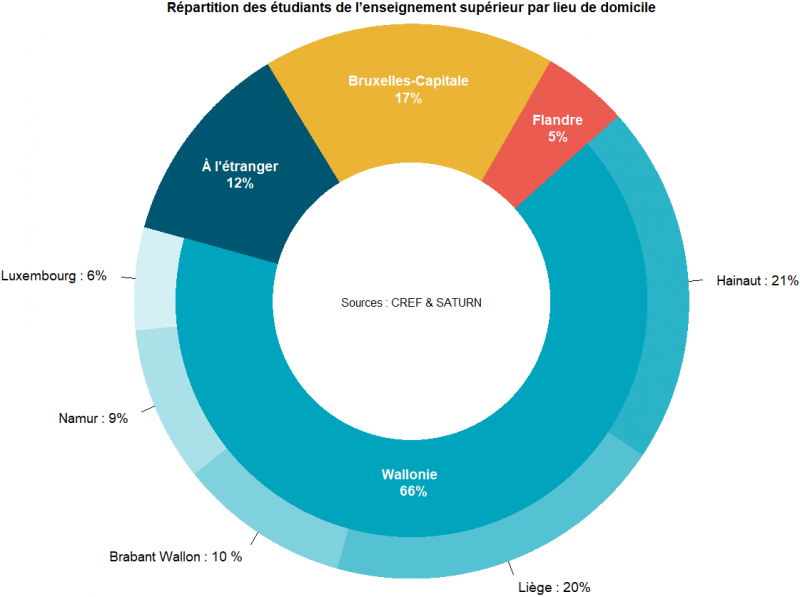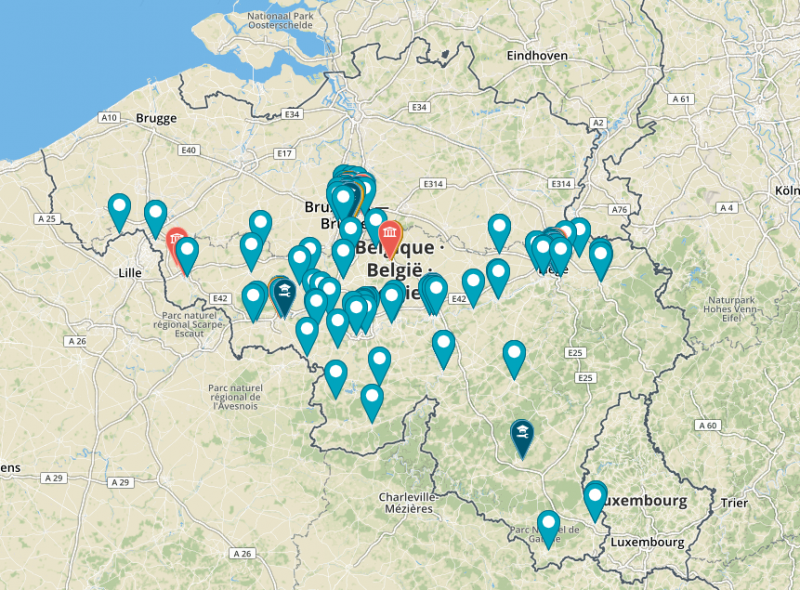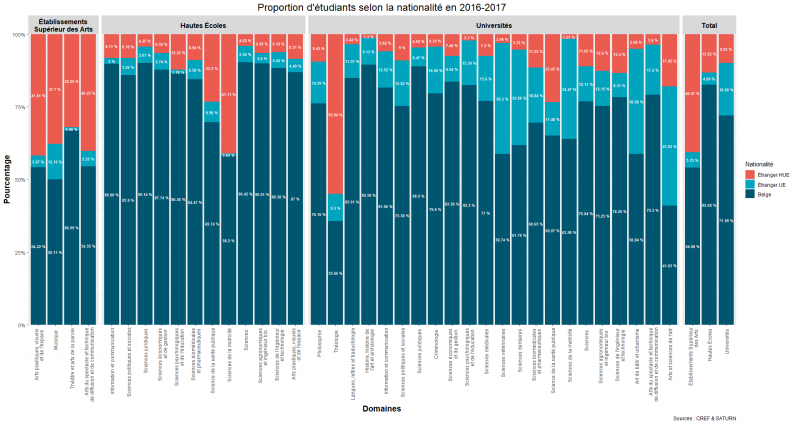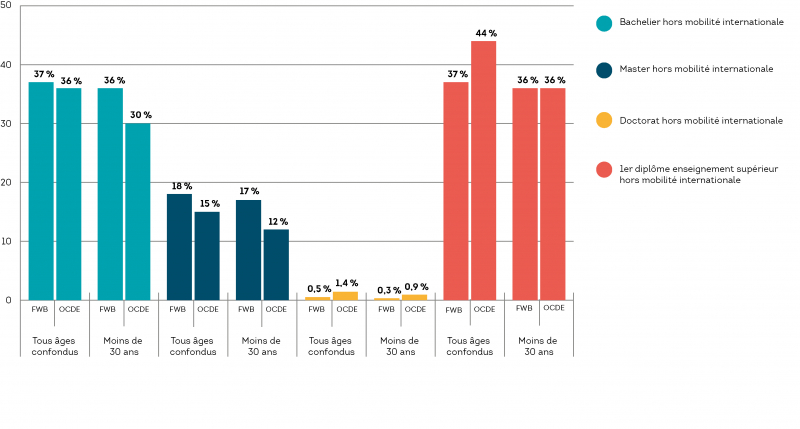One of ARES's main tasks is to manage a system for collecting statistical data on higher education and to publish the results. In this context, the institution is involved in developing statistical indicators for higher education in the Wallonia-Brussels Federation and internationally. Depending on the case, ARES either produces the indicators itself, acts as a data provider or participates in developing the methodology for producing them.
The indicators we publish are designed to be clear, easy to access and well documented. They are a management tool for decision-makers and a source of information for the public.
At the bottom of the page, you will find information on the sources of the data and the different contexts in which we develop these indicators.
You can also find other indicators on the website mesetudes.be.
Context indicators

In the Wallonia-Brussels Federation, most pupils and students in education, at all levels, live in Wallonia and the Brussels-Capital Region. They represent 84% of students. In addition, in higher education, a significant proportion of students (12%) live abroad and 5% live in the Flemish Region.

The map shows higher education institutions in the Wallonia-Brussels Federation and their campuses. To view the interactive map, visit our Opendata portal.
Secondary-to-higher education transition indicators

The first-time access rate is an estimate of the probability that young adults will start their first education at some point in their lives if current access rates remain the same in the future.
The rate of access to higher education for young people in the FWB is 3 percentage points higher than the OECD average. However, it is 11 points higher for young people under 25. In the FWB, higher education seems to be the logical continuation of compulsory education (the access rate for under-25s is almost equal to that for entrants of all ages1).
1. It should be noted, however, that the lack of age-specific data for adult higher education means that students entering higher education for the first time via adult higher education cannot be taken into account.
A first-generation student is a student who:
- has never attended higher education anywhere (at least during the last five years for university colleges and arts colleges, due to a lack of more precise information),
- and is enrolled in the first 60 credits of the first cycle (first year).
Only first-generation students with a CESS secondary school certificate from the FWB as their entry qualification are eligible. This certificate is awarded at the end of the sixth year of secondary school, except for vocational secondary education, where it is awarded at the end of the seventh year.
Age is calculated at midnight on 31 December of the academic year.
Performance indicators

An international student is a student who leaves their country of origin to go to another country with the intention of studying. As there is a high probability that these individuals will return to their country of origin once they have graduated, they have been excluded from the data.
In FWB, the first degree is, with some exceptions, a bachelor's degree. This is mainly awarded to students who continue their studies directly after secondary education (same as for first-time entrants)1.
1. Adult higher education diplomas are not taken into account (lack of data).
For each academic year, the cohort is made up of students:
- who have never attended higher education anywhere (at least during the last five years for university colleges and arts colleges due to lack of information;
- are regularly enrolled in the first 60 credits of the first cycle (first year) or enrolled in blocks 1 to 60 credits (enrolment in the 60 credits of block 1 cannot be guaranteed for the CREF);
- not having dropped out before 1 December of the academic year (by default, students who have paid the balance of their registration fees are taken into account);
- having 60 credits registered in the study programme at the time of registration.
The following are therefore not taken into account:
- students with reduced enrolment (as a result, students with late reductions are also excluded from the scope)
- ‘young talent’ students (this information only concerns arts colleges).
Some clarifications:
- First credits of the cycle: the student is enrolled in block 1 within the first 60 credits of the cycle. They are not required to have 60 credits in the PAE;
- Last credits of the cycle: the student is enrolled in the last credits of the cycle. The number of credits enrolled in the study programme varies;
- In programme follow-up: all other students who have validated at least the first 45 credits of the programme and whose study programme does not include the final credits of the programme.
The amendments to the decree on landscape architecture from the start of the 2022-2023 academic year will only affect this classification from the start of the 2023-2024 academic year.
‘Young talent’ students (arts colleges) and independent or irregular students are not taken into account.
Advanced bachelor’s degrees, certified upper secondary education teacher (AESS) and advanced master's degrees are not taken into account.
There is no division in terms of position in the cycle for master's degrees.
The data only starts in 2017-2018, as from 2014-2015 to 2016-2017 the data is still organised by year of study and there are many unknowns.
Some additional information: data sources and development contexts
Pending the availability of data from the single data collection (project in progress), the information used to calculate the indicators developed comes from the following sources:
- SATURN database (higher education outside universities)
- database of the Council of French-speaking Rectors[of Belgium] - CREF (universities)
- Pilotage database (compulsory education)
- UOE data collection
- Federal Public Service Economy Labour Force Survey (Belgium)
- ...
The last reference year for Wallonia-Brussels Federation publications and international publications is 2013-2014. This is also the last year for which all current sources have data available.
These indicators are produced:
- As part of various projects carried out by the Wallonia-Brussels Federation in response to legal mandates such as the management of education and statistical synergies:
- annual publication of the Education Indicators.
- publication The Wallonia-Brussels Federation in figures.
- Based on data sent to the European Union under the European Regulation on Statistics on Education and Training throughout Life (joint UNESCO-OECD-Eurostat data collection on formal education systems) to feed into the EUROSTAT database or to produce the indicators for Education at a Glance, OECD indicators.
- Within the framework of international statistical or policy programmes (Education and Training 2020 strategy, Europe 2020, OECD Indicators of Education Systems [INES], etc.), based on methodologies developed by international experts, including Nathalie Jauniaux, Director of the Research and Statistics Department at ARES.
